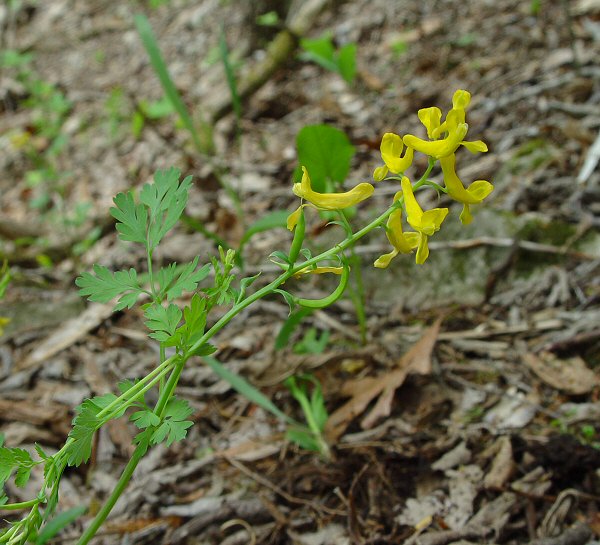Corydalis aurea ssp. occidentalis (Engelm. ex A. Gray) G.B. Ownbey
Golden Corydalis

Native
CC = 5
CW = 5
MOC = 42
© DETenaglia
Corydalis aurea ssp. occidentalis (Engelm. ex A. Gray) G.B. OwnbeyGolden Corydalis | |
 |
Native CC = 5 CW = 5 MOC = 42 |
© DETenaglia |
|
Family - Fumariaceae Habit - Taprooted annual or biennial. Plants often gray and glaucous. Stems - Loosely to strongly ascending, to 35 cm, often from a spreading base.
Leaves - Basal and lower stem leaves with the petiole 3-6 cm long, the upper leaves sessile or very short-petiolate. Leaf blades 1.5-10.0 cm long, with mostly 7-11 pinnae, these again 1 or 2 times deeply several-lobed, the ultimate segments linear or narrowly to occasionally broadly oblong-elliptic or lanceolate. Inflorescences - Racemes of 5-30 flowers, extending past the foliage, all with open flowers. Flower stalks 2-4 mm long, ascending at flowering, ascending or pendant at fruiting. Flowers - Corollas pale to bright yellow, the upper outer petal 13-18 mm long, the spur 4-9 mm long, straight or nearly so, the concave apical portion with a low, irregular crest or more often merely keeled.
Fruits - Capsules 15-18 mm long, ascending at maturity, straight or curved, glabrous, not appearing mealy. Seeds 1.8-2.1 mm long, the surface smooth or nearly so, the bluntly to sharply angled rim sometimes with a minute, raised ridge.
Flowering - March - June. Habitat - Rocky woods, open ground. Origin - Native to U.S. Lookalikes - Other species of Corydalis, especially C. micrantha. Other info. - This species can be found in widely scattered locations across Missouri but is generally uncommon in the state. It is much more abundant in western states. Species of Corydalis can be somewhat difficult to distinguish. This particular one has the largest flowers of any of Missouri's members of the genus. The spurs are straight or nearly so, the foliage tends to be silvery, and the fruits are often held ascending or erect. Photographs taken at Earthquake Hollow Conservation Area, Callaway County, MO., 4-22-04 (DETenaglia). |